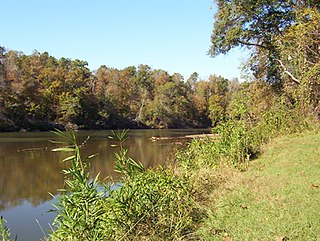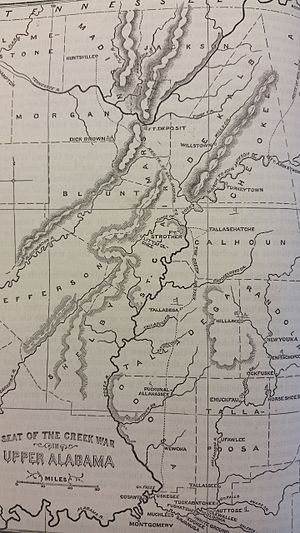
The Muscogee, also known as the Mvskoke, Muscogee Creek, and the Muscogee Creek Confederacy, are a group of related Indigenous peoples of the Southeastern Woodlands in the United States of America. Their historical homelands are in what now comprises southern Tennessee, much of Alabama, western Georgia and parts of northern Florida.

The Battle of Horseshoe Bend, was fought during the War of 1812 in the Mississippi Territory, now central Alabama. On March 27, 1814, United States forces and Indian allies under Major General Andrew Jackson defeated the Red Sticks, a part of the Creek Indian tribe who opposed American expansion, effectively ending the Creek War.

The Creek War, was a regional conflict between opposing Native American factions, European powers, and the United States during the early 19th century. The Creek War began as a conflict within the tribes of the Muscogee, but the United States quickly became involved. British traders and Spanish colonial officials in Florida supplied the Red Sticks with weapons and equipment due to their shared interest in preventing the expansion of the United States into regions under their control.
Red Sticks, the name deriving from the red-painted war clubs of some Native American Creek—refers to an early 19th century traditionalist faction of these people in the Southeastern United States. Made up mostly of Creek of the Upper Towns that supported traditional leadership and culture, as well as the preservation of communal land for cultivation and hunting, the Red Sticks arose at a time of increasing pressure on Creek territory by European American settlers. Creek of the Lower Towns were closer to the settlers, had more mixed-race families, and had already been forced to make land cessions to the Americans. In this context, the Red Sticks led a resistance movement against European American encroachment and assimilation, tensions that culminated in the outbreak of the Creek War in 1813. Initially a civil war among the Creek, the conflict drew in United States state forces while the nation was already engaged in the War of 1812 against the British.

The Fort Mims massacre took place on August 30, 1813, during the Creek War, when a force of Creek Indians belonging to the Red Sticks faction, under the command of head warriors Peter McQueen and William Weatherford, stormed the fort and defeated the militia garrison. Afterward, a massacre ensued and almost all of the remaining Creek métis, white settlers, and militia at Fort Mims were killed. The fort was a stockade with a blockhouse surrounding the house and outbuildings of the settler Samuel Mims, located about 35 miles directly north of present-day Mobile, Alabama.
Hitchiti was a tribal town in what is now the Southeast United States. It was first known as part of the Apalachicola Province, an association of tribal towns along the Chattahoochee River. Shortly after 1690, the towns of Apalachicola Province moved to the central part of present-day Georgia, with Hitchiti joining most of those towns along Ochese Creek. In 1715, most of the towns on Ochese Creek, including Hitchiti, moved back to the Chattahoochee River, where the town remained until its people were forced to move to the Indian Territory as part of the Trail of Tears. Hitchiti was one of several towns whose people spoke the Hitchiti language.

Okfuskee are a Muscogee tribe. Alternative spellings include the traditional Mvskoke spelling "Akfvske", referring to the tribal town in Alabama, and the comparable spelling Oakfuskee. They formed part of the former Creek (Muscogee) Confederacy in Alabama, prior to their removal during the 1830s to the Indian Territory. Okfuskee County, Oklahoma is named for a settlement where members of the tribe formerly lived.
Abihka was one of the four mother towns of the Muscogee Creek confederacy. Abihka is also sometimes used to refer to all Upper Creek people.

Fort Williams was a supply depot built in early 1814 in preparation for the Battle of Horseshoe Bend. It was located in Alabama on the southeast shore where Cedar Creek meets the Coosa River, near Talladega Springs.
McIntosh Road is a historic Native American route in the northern part of the U.S. states of Alabama and Georgia. It was named for the prominent Creek Indian chief William McIntosh, a leader of the Lower Towns. He helped improve it in the early 19th century, to connect Creek towns in what are now two states.

The Tallapoosas were a division of the Upper Creeks in the Muscogee Confederacy. Prior to Removal to Indian Territory, Tallapoosa lived along the Tallapoosa River in Alabama.
Fushatchee was a band of Muscogee Native Americans. They were located in Alabama and Florida in the United States.
Hickory Ground, also known as Otciapofa is an historic Upper Muscogee Creek tribal town and an archaeological site in Elmore County, Alabama near Wetumpka. It is known as Oce Vpofa in the Muscogee language; the name derives from oche-ub,"hickory" and po-fau, "among". It is best known for serving as the last capital of the National Council of the Creek Nation, prior to the tribe being moved to the Indian Territory in the 1830s. It was added to the National Register of Historic Places on March 10, 1980.

Josiah Francis, also called Francis the Prophet, native name Hillis Hadjo, was "a charismatic religious leader" of the Red Stick Creek Indians. According to the historian Frank Owsley, he became "the most ardent advocate of war against the white man, as he believed in the supremacy of the Creek culture over that of the whites". He traveled to London as a representative of several related tribal groups, unsuccessfully seeking British support against the expansionism of the United States, then was captured and hanged by General Andrew Jackson shortly after his return to Spanish Florida.
Brownsville is an unincorporated community in Clay County, Alabama, United States.
Pinckneyville, also spelled as Pinkneyville, is an unincorporated community in Clay County, Alabama, United States.

The Taskigi Mound or Mound at Fort Toulouse – Fort Jackson Park (1EE1) is an archaeological site from the South Appalachian Mississippian Big Eddy phase. It is located on a 40 feet (12 m) bluff at the confluence of the Coosa and Tallapoosa rivers where they meet to form the Alabama River, near the town of Wetumpka in Elmore County, Alabama.

Selocta Chinnabby was a Muskogee Creek chief from present-day Talladega County, Alabama. He allied himself with the Andrew Jackson in fighting the Red Sticks in the Creek War, which was part of the larger War of 1812.
The Choccolocco Creek is one of two main tributaries of the Coosa River in central Alabama. The watershed of the creek comprises 246,000 acres (376 mi2) of drainage area. The waterway runs through the Choccolocco State Forest, and crosses through Calhoun, Talladega, Cleburne, and Clay counties in central Alabama.










